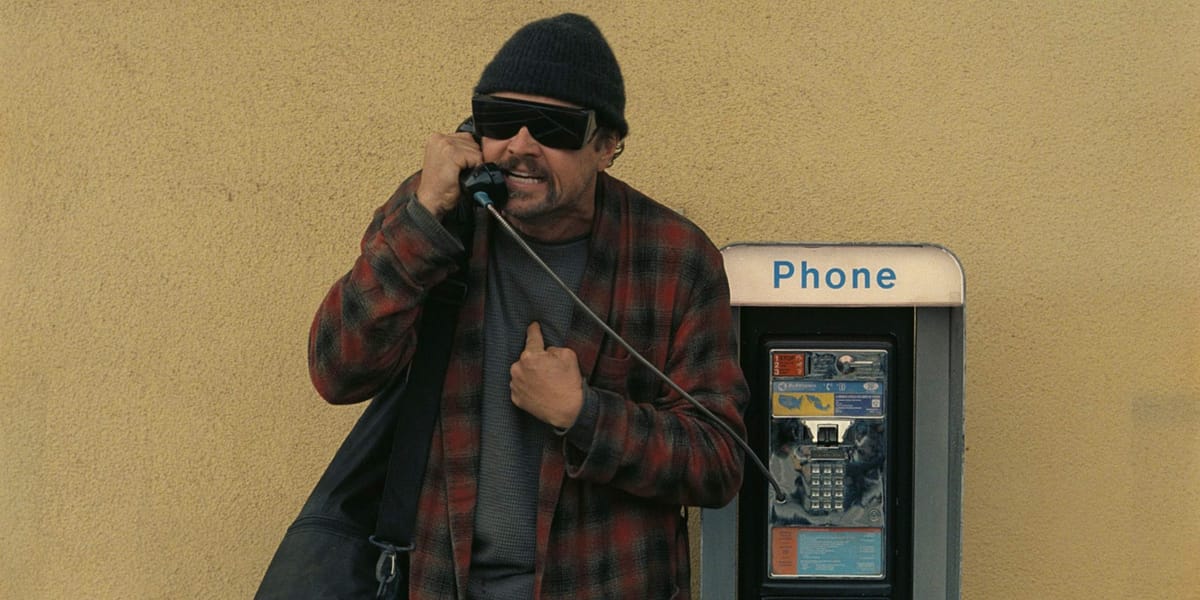The Revolution WILL Be Televised
In lieu of mythologizing, One Battle After Another and Andor focus on organizational commitment and personal sacrifice needed to fuel a revolution.

This article contains spoilers for One Battle After Another and Andor.
This article is the second part in a two-part series examining cinematic depiction of revolution. Part one detailed the pitfalls into which many recent revolutionary stories have fallen: they demand absolute moral purity in revolutionary characters and they mythologize revolutionary symbolism without giving much attention to the details of how a revolutionary movement actually functions. Such shortcomings can lead to work that is actually counterproductive to revolutionary causes. These works give us comfortable, shallow images of revolution which keep us sated in commercial media instead of spurring us to put down our phones, leave our couches, and pursue real change. They are the fulfillment of the consumerist subsumption of rebellion Gil Scott-Heron lambasted in his 1971 song “The Revolution Will Not Be Televised.”
But lately, there has been progress towards a more effective revolutionary cinema. This second part of our series, then, will focus on that progress through two recent works: One Battle After Another and Andor. “The Revolution Will Not Be Televised” in fact has a major presence in One Battle After Another, and its prominence suggests writer-director Paul Thomas Anderson is aware of the challenge the song poses for revolutionary cinema and is actively striving to meet it. While neither this film nor Andor completely solve such a substantial challenge, they make great strides that represent a welcome shift in popular media’s depiction of revolution. They portray it are far more grounded and complex than the myths we usually get. They depict revolutionary struggle as a product of collective organization, not just a few exceptional individuals. They reject the simplicity of both the morally flawless revolution and the glorious, spontaneous revolution, instead giving a more nuanced account of the struggle against authoritarianism more applicable to the struggles we face in the real world.
At one point in One Battle After Another, our lead character Bob is in his home watching the opening of the 1966 film The Battle of Algiers. Such a film is almost too obvious a reference point; The Battle of Algiers is the godfather of the modern revolutionary film. Every revolutionary film that came later is emulating it to some degree. Its depiction of rebellion, though, is entirely unlike the picture popular cinema would come to adopt. Filmed in a neorealist style on location in Algiers just a handful of years after the events it is based on, the film is too close to real history to do any mythmaking. Its presentation is more akin to a documentary or newsreel with its handheld camera roaming the streets. It depicts meticulously the events of its conflict but does not take sides. It does not shy away from the conflict’s brutality either, showing bombings against civilians committed by both sides and the torture employed by the French. It leaves questions of morality and justice to the audience.
An essential aspect of the revolution in The Battle of Algiers is its decentralization. The network of Algerian rebels is organized such that every member has only a couple contacts, and no one save the very highest-ranking rebels knows the full structure of the organization. The result is that the rebellion becomes anonymous; to the French, any Algerian in the street, from a small child to an old woman, could conceivably be part of the rebellion. It feels not as though there is a clear organization battling the French for control of the city, but as though the city itself is rising up in defiance of colonial rule.
In summary, revolution in The Battle of Algiers is messy and decentralized. It requires total commitment, including neglect of ethical principles in service of a greater political aim, and offers no glory in exchange. We get a similar picture of rebellion in One Battle After Another, which is not shy about identifying the actions of the French 75 throughout the first act of the film as terrorism. But it is Andor that really takes up this vision. It is notable that none of the central characters in the show are those who would eventually get the credit for the Empire’s defeat. Many of them, in fact, are long dead by that point. Instead of the poster boy Rebels who get to blow up the Death Star and become eternal symbols, we focus on those who do the thankless, anonymous work of slowly building the Rebellion to that position, sacrificing all other commitments to do so.
Foremost among these characters is Luthen, part of the Rebellion’s central brain trust who has given all his morals and inner peace in service to the Rebellion. “I burn my decency for someone else’s future. I burn my life to make a sunrise that I know I’ll never see,” he says in an epic monologue defending his commitment. And he has indeed burned his decency. Luthen is ruthless, cold, manipulative. He spies on his allies just as much as his enemies. He trades lives without remorse. He kills his friends when their risks outweigh their uses. This is the kind of rebel most popular revolutionary stories, with their demands for moral purity, could never stomach. The show recognizes and depicts this very pearl-clutching in the finale. Luthen’s years-long cultivation of his spy network has given the Rebellion its first intelligence of the Death Star, but when Cassian delivers this intelligence to the Rebel council on Yavin IV, most of its members are inclined to disregard it based on their distaste for Luthen’s character. Such moral fastidiousness would have destroyed the Rebellion were it not for Cassian’s impassioned plea on Luthen’s behalf, pointing out that none of what the Rebellion has built would be there without him.
Just as One Battle After Another and Andor embrace moral murkiness in their revolutions, they also avoid the simplicity of basing revolution wholly on symbolism and the sudden, decisive victory of freedom over oppression. Andor is certainly aware of the power of symbols and rhetoric in revolution. More than once throughout the series an impassioned speech sparks an immediate riot. But the show does not take such rhetoric by itself to be sufficient to sustain a rebellion. Amongst all the riots and big speeches and symbols of freedom, the show devotes enormous attention to the organization of the Rebel network: how it launders and distributes its money, how it manages uneasy alliances between groups opposed to the Empire but that also do not much like each other, how it maintains secrecy, how it gathers and passes along intelligence. The open acts of defiance are only the visible tip of a much more intricate iceberg, not the revolution entire.
The show has one character, Nemik, who is something of a political philosopher. He has written a manifesto about the Empire’s oppression and talks Cassian’s head off with his revolutionary ideologies. A lesser story might have centered Nemik as one of the characters most responsible for the success of the Rebellion, had him, the innocent true believer, be the one to make the big speeches and become a symbol for the people. But the show does not do this. Nemik certainly has a major part to play in the Rebellion; he is a key figure in radicalizing Cassian and by the end of the series his manifesto has spread throughout the galaxy, but ideology alone does not a revolution make. For his talents as a thinker, Nemik isn’t much of a soldier. In fact, he dies on his very first mission. He can help provide an ideological grounding for the Rebellion, but there still needs to be a strong revolutionary structure in place for people to act on that ideology. Revolution will not just spring up out of nowhere, fully formed, if he gets his manifesto to enough people.
One Battle After Another is much more critical of the role of symbolism in a revolution. In the eyes of the film, too keen a focus on the aesthetics of a revolution can turn the movement into something self-aggrandizing instead of something working towards real change. The film begins with a “declaration of war.” While breaking a group of immigrants out of a detention camp, Perfidia Beverly Hills makes a big speech proclaiming the principles of the French 75 and their war on the U.S. government. Bob shoots rockets into the night sky to mark the occasion and makes an improvised speech of his own. It is an exciting, bombastic display of revolutionary spirit, and the kind of activity characteristic of the French 75 over the film’s first act as they blow up government offices and rob banks and make their proclamations in the name of freedom. But all of that revolutionary bravado, all of that rhetoric and all of those symbolic displays, never seem to accomplish anything. When the film jumps ahead sixteen years, it makes a point of stating that nothing much has really changed.
Perfidia is the character who best embodies this self-aggrandizing rebellion. She is the most vocal rhetorician of the French 75, the one most enamored with the big displays of defiance. Rebellion is a total thrill for her. It turns her on, which we see repeatedly throughout the film’s first act as she gets aroused by her own terroristic activities. And so when she becomes pregnant and has a daughter, she cannot acknowledge that this represents a major change in her life. It would be an interruption to her rebellious adventuring, a responsibility that would prevent her from living so recklessly. So she refuses to commit to her new family and goes on with her revolutionary escapades. She defends her actions as a commitment to the cause above personal interests, but we see that this is a false justification when she rats out her comrades to save herself once captured by the government. For Perfidia, the revolution is not really a concrete goal to strive towards. It is the means to a life of personal excitement as she gets to play freedom fighter. Her grand symbolism turns out to be self-absorption.
This same infatuation with symbols and rhetoric over concrete goals persists in the French 75 after the film’s time jump, most clearly in the running gag of the group’s stubborn adherence to code speak. In Bob’s constant arguing with the man on the other end of the hotline over the password he can’t remember, we find a group more concerned with keeping up the appearances of a revolutionary cell, abiding by all the rituals and procedures, than actually giving help to someone in need of it. The actual answer to the prompt “What time is it?” is “Time doesn’t exist, but it controls us anyway,” which is a perfect punchline to highlight the self-absorption of this rebellion. The French 75 hotline’s hold music is “The Revolution Will Not Be Televised,” and lyrics from the song are used as one of the organization’s code phrases. There is a deep irony here. By invoking the song and many other pieces of revolutionary symbolism without taking meaningful action towards the causes those works advocate, the French 75 are missing Gil Scott-Heron’s entire point.
The film does give us, though, a better model of revolutionary behavior in another character: Benicio Del Toro’s Sensei Sergio St. Carlos. He makes no big pronouncements or displays of his ideology. He appears on the surface to just be an ordinary citizen. But that’s because his revolutionary spirit is directed towards action, not symbolic displays. He runs what he calls a “Latino Harriet Tubman situation” in his apartment, housing immigrant families hiding out from the government. When the government comes into town looking to round up immigrants, he already has a plan in place and uses a hidden tunnel to immediately and efficiently evacuate the families out of the apartment building and get them to the sanctuary of a church. Bob comes to the door of his dojo looking for help, and St. Carlos assists him without hesitation. This is a man who does not spend his energy talking the talk of revolution without walking the walk. He organizes within his community, develops and executes plans with clear objectives, and helps those in need instinctually. This, the film shows us, is the behavior of a real revolutionary.
By abandoning symbolic glorification and moral purity, One Battle After Another and Andor give us detailed accounts of revolution that do not rely on a simple binary of good revolutionaries versus evil empire. This is especially significant because in promoting rebellion against the oppressive forces of our world, it encourages us to see those oppressive forces not as monolithic blocks of evil, but as their own intricate institutions. This enables us, then, to see both how they go about oppressing people and also how they might be defeated.
In both of these works, the authoritarian forces of oppression are vulnerable to the same kind of systemic weaknesses that rebel organizations are, and these weaknesses become the oppressors’ downfalls. In One Battle After Another, our antagonistic organization is the secret cabal of the Christmas Adventurers, and it is their own insistence on keeping up appearances, here based on bigotry instead of ideals of freedom, that proves to be the saving grace for our heroes. Much of the film’s conflict ultimately gets resolved through the Christmas Adventurers’ own infighting as they try to keep up their veneer of racial purity. One of their prospective members, Colonel Lockjaw, has committed the apparent mortal sin of having a child with a Black woman, and in the various characters’ scrambling to rid themselves of this blight, they end up killing each other. For whatever self-aggrandizing the French 75 are guilty of, the Christmas Adventurers far surpass it, and this makes it inevitable that they will collapse in on themselves.
In Andor, much of the Rebellion’s success comes from infiltrating the bureaucracy of the Empire. In doing so the Rebels are able to learn about all the bureaucracy’s power struggles and manipulate those conflicts to keep the Empire off their scent for years. The discovery of the Death Star comes largely as a result of one Imperial officer’s ambition to bypass the bureaucracy making her careless with sensitive information. Throughout the series, the institutional weight of the Empire becomes its downfall. In examining oppressive structures closely, One Battle After Another and Andor can illuminate patterns of weakness in real-world institutions that revolutionaries can exploit. This is only possible, though, by shedding the mythic conception of revolution that removes all organizational nuance in favor of static ideology.
These, then, are the benefits of the revolutionary cinema that One Battle After Another and Andor embody: in more grounded, complex accounts of revolution, we are better able to see the organization, commitment to action, and personal sacrifice necessary to bring about a revolution and also get a clearer view of the weaknesses of the regimes we are rebelling against. Revolution turns from glorious myth into something actionable. This is significant progress. But it does not represent a total solution to the problems faced by revolutionary media that Gil Scott-Heron suggested. For these are still commercial works of art being put out by multi-billion dollar corporations to entertain us. The revolution is still being televised. Is there any way around this problem?
No work of art is ever going to bring about a revolution on its own. Thinking as much would ignore all of the points about symbolism I have been making. The best that works like these can do is model revolutionary behavior for us and inspire us to take up that behavior towards worthy causes. But it’s still up to us to act. So while they don’t break through the limitations of revolutionary cinema, One Battle After Another and Andor do much better than previous efforts working within those limitations.
One final feature of both stories critical to their effectiveness at getting us to carry rebellion beyond the screen: neither work gives us the satisfaction of seeing authoritarianism toppled. There is no ending like that of V for Vendetta, where seats of oppression are blown up in a joyous symphony and we all get to rejoice. The authoritarian government is still firmly in place and the Christmas Adventurers are still doing their adventuring at the end of One Battle After Another. Andor ends well before any hint of the Empire’s ultimate defeat has come. Instead, it is another day on Yavin, another day for the Rebellion, and we follow Cassian as he gets to work. Instead of ending on notes of victory, these works end on the idea of continuing the struggle. Revolution isn’t something that you do once and then it’s over. It’s an ongoing way of living. It’s one battle after another. We do it not for ourselves, but for our children, for the future generations who will themselves take up the struggle and perhaps see a better world emerge somewhere down the line. In Andor’s final scene, we reunite with Bix and a baby we can only assume is Cassian’s, a reminder of the world we are fighting for that usually seems so far-off. And at the end of One Battle After Another, we see that Bob’s revolutionary spirit has been taken up by his daughter, who rushes out of the house after hearing a distress call to drive off and help. Gil Scott-Heron’s song spends most of its length focusing on all the things the revolution is not, but here it seems appropriate to note what he says that it is: “The revolution will put you in the driver’s seat. … The revolution will be live.”




